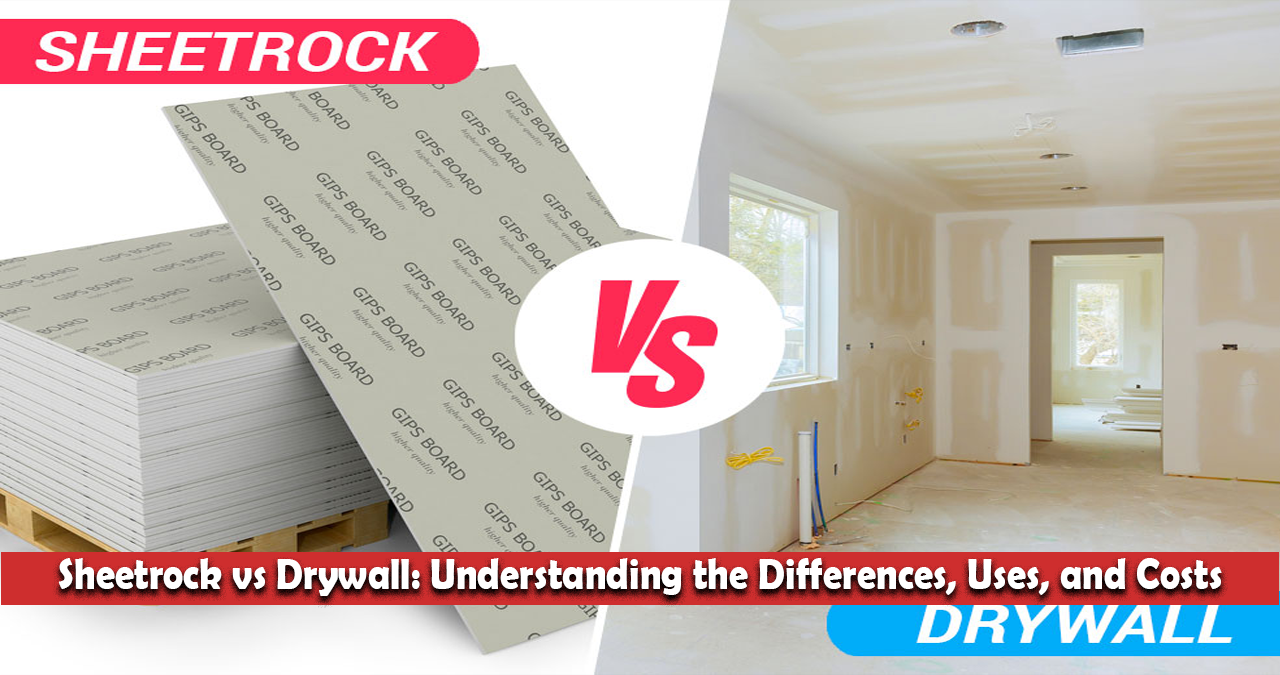When it comes to building or renovating walls and ceilings, two terms often come up: Sheetrock and drywall. While many people use these terms interchangeably, they aren’t exactly the same thing. Whether you’re a DIY enthusiast or a professional contractor, understanding the differences between Sheetrock and drywall can help you make informed decisions for your projects. In this article, we’ll dive deep into the Sheetrock vs drywall debate, covering everything from their history and manufacturing to their uses, costs, and more.
What is Drywall?
Drywall is a construction material used to create interior walls and ceilings. It consists of a core made of gypsum plaster, which is sandwiched between two thick sheets of paper. Gypsum is a naturally occurring mineral that is fire-resistant and easy to work with, making it an ideal material for construction.
Drywall is also known by other names, such as plasterboard, wallboard, gypsum board, or gyprock. It was invented as a faster and more efficient alternative to the traditional lath and plaster method, which was time-consuming and labor-intensive. Drywall installation is quicker, requires less skill, and is more cost-effective, which is why it has become the standard in modern construction.
One of the key advantages of drywall is its versatility. It comes in various types, including fire-resistant, moisture-resistant, soundproof, and mold-resistant options. This makes it suitable for different environments, from residential homes to commercial buildings.
What is Sheetrock?
Sheetrock is essentially a brand of drywall. It is a registered trademark of the U.S. Gypsum Company (USG), one of the largest manufacturers of construction materials in the world. The term “Sheetrock” has become so popular that it is often used generically to refer to any type of drywall, much like how “Kleenex” is used to describe facial tissues.
Sheetrock was first introduced in 1917 and quickly gained popularity due to its consistent quality and ease of use. While it is technically just a brand of drywall, Sheetrock has some unique features that set it apart from generic drywall. For example, USG uses specific additives in their Sheetrock products to enhance performance, such as improved fire resistance, mold resistance, and sag resistance.
Despite these differences, Sheetrock and drywall are used in the same way—for constructing interior walls and ceilings. The choice between the two often comes down to personal preference, budget, and specific project requirements.
Sheetrock vs Drywall: Key Differences

While Sheetrock and drywall are very similar, there are a few key differences that set them apart. Let’s break them down:
1. Brand vs Material
The most significant difference is that Sheetrock is a brand, while drywall is a material. Think of it like this: all Sheetrock is drywall, but not all drywall is Sheetrock. Other brands of drywall include CertainTeed, Georgia-Pacific, and National Gypsum.
2. Composition
Both Sheetrock and drywall are made from gypsum plaster and paper. However, Sheetrock may contain a few proprietary additives that enhance its performance, such as increased fire resistance or mold resistance. These additives are part of the reason why Sheetrock is often considered a premium product.
3. Price
When it comes to Sheetrock vs drywall price, Sheetrock tends to be slightly more expensive than generic drywall. This is because of the brand name and the additional features it offers. However, the price difference is usually minimal, and many contractors prefer Sheetrock for its reliability and consistency.
4. Availability
Sheetrock is widely available in the United States, but it may not be as common in other countries. Generic drywall, on the other hand, is produced by numerous manufacturers worldwide, making it more accessible in some regions.
5. Quality Control
Because Sheetrock is produced by a single company (USG), it undergoes strict quality control measures. This ensures that every Sheetrock panel meets high standards. Generic drywall, especially from lesser-known manufacturers, may not always have the same level of quality control.
Sheetrock vs Drywall for Ceiling
When it comes to ceilings, both Sheetrock and drywall are excellent choices. However, there are a few factors to consider:
Sag Resistance
Ceilings are prone to sagging over time, especially in humid environments. Sheetrock offers specialized sag-resistant panels that are lighter in weight and designed to maintain their shape. If you’re working on a ceiling, opting for sag-resistant Sheetrock can save you from future headaches.
Moisture Resistance
For ceilings in bathrooms, kitchens, or other high-moisture areas, moisture-resistant drywall (often called green board) is a must. Both Sheetrock and generic drywall offer moisture-resistant options, but Sheetrock’s Mold Tough panels are particularly effective at preventing mold growth.
Ease of Installation
Installing drywall on a ceiling can be challenging due to the weight and the need for precise cutting. Sheetrock panels are often lighter and easier to handle, making them a popular choice for ceiling installations.
Sheetrock vs Drywall Price
One of the most common questions is: Is Sheetrock more expensive than drywall? The answer is yes, but the difference is usually minimal. On average, Sheetrock costs about 10-20% more than generic drywall. For example, a standard 4×8-foot panel of drywall might cost around $10, while a similar Sheetrock panel could cost $12.
However, the price can vary depending on the type of drywall. Specialty products, such as fire-resistant or mold-resistant panels, will cost more regardless of the brand. When budgeting for your project, it’s important to consider not just the upfront cost but also the long-term benefits of using high-quality materials.
Types of Drywall and Sheetrock
Both drywall and Sheetrock come in a variety of types to suit different needs. Here’s a quick overview:
Standard Drywall
- Thickness: 1/4-inch to 3/4-inch
- Use: General-purpose walls and ceilings
Fire-Resistant Drywall
- Contains glass fibers to increase fire resistance
- Ideal for garages, utility rooms, and shared walls
Moisture-Resistant Drywall (Green Board)
- Treated with water-resistant additives
- Perfect for bathrooms, kitchens, and basements
Mold-Resistant Drywall
- Contains mold inhibitors
- Great for high-humidity areas
Soundproof Drywall
- Includes damping polymers to reduce noise transmission
- Ideal for home theaters, bedrooms, and offices
Specialty Sheetrock
- Foil-Back: Acts as a vapor barrier
- Sag-Resistant: Designed for ceilings
- Abuse-Resistant: Withstands impacts and scratches
Sheetrock vs Drywall: Which Should You Choose?
The choice between Sheetrock and drywall ultimately depends on your specific needs and budget. Here are a few scenarios to help you decide:
- Choose Sheetrock if: You want a trusted brand with consistent quality, or if you need specialized features like mold resistance or sag resistance.
- Choose Generic Drywall if: You’re working on a tight budget or don’t need the additional features offered by Sheetrock.
Regardless of your choice, always ensure that the drywall you purchase is from a reputable manufacturer. Poor-quality drywall can lead to issues like cracking, mold growth, and even health problems due to off-gassing.
FAQs
1. Is Sheetrock better than drywall?
Sheetrock is not necessarily better than drywall; it’s just a brand of drywall. However, Sheetrock is known for its consistent quality and specialized products, which can make it a better choice for certain projects.
2. Can I use Sheetrock for ceilings?
Yes, Sheetrock is an excellent choice for ceilings, especially its sag-resistant panels.
3. What’s the difference between green board and regular drywall?
Green board is moisture-resistant drywall, making it suitable for high-humidity areas like bathrooms and kitchens. Regular drywall is not moisture-resistant.
4. How much does Sheetrock cost compared to drywall?
Sheetrock typically costs 10-20% more than generic drywall, but the price difference is usually minimal.
5. Can I use Sheetrock for exterior walls?
No, Sheetrock and drywall are designed for interior use only. For exterior walls, you’ll need materials like cement board or plywood.
Conclusion
In the Sheetrock vs drywall debate, there’s no clear winner—it all depends on your project requirements and budget. Both materials are excellent for constructing walls and ceilings, and they offer a range of options to suit different needs. Whether you choose Sheetrock for its premium features or opt for generic drywall to save money, you can’t go wrong as long as you select a high-quality product.
So, the next time you’re planning a construction or renovation project, you’ll know exactly what to look for when it comes to Sheetrock and drywall. Happy building!
External Links:
Quotes:
- “Sheetrock is to drywall what Kleenex is to facial tissue—a brand name that’s become synonymous with the product itself.”
- “When it comes to ceilings, sag-resistant Sheetrock is a game-changer.”
Table:
| Feature | Drywall | Sheetrock |
|---|---|---|
| Material | Gypsum plaster + paper | Gypsum plaster + paper |
| Brand | Generic | USG (brand) |
| Price | Lower | Slightly higher |
| Special Features | Varies by manufacturer | Mold Tough, Firecode |
| Availability | Worldwide | Primarily in the U.S. |



